
A gurdwara or gurudwara is a place of assembly and worship for Sikhs. Sikhs also refer to gurdwaras as Gurdwara Sahib. People from all faiths and religions are welcomed in gurdwaras. Each gurdwara has a Darbar Sahib where the Guru Granth Sahib is placed on a takht in a prominent central position. Any congregant may recite, sing, and explain the verses from the Guru Granth Sahib, in the presence of the rest of the congregation.
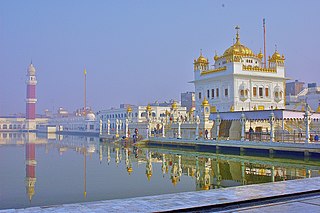
Tarn Taran Sahib is a city in the Majha region of the state of Punjab, in northern India. It is the district headquarters and hosts the municipal council of Tarn Taran district. Gurdwara Sri Tarn Taran Sahib, a prominent Sikh shrine is located in the central part of the city.
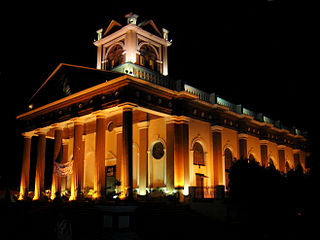
Kapurthala is a city in Punjab state of India. It is the administrative headquarters of Kapurthala District. It was the capital of the Kapurthala State, a princely state in British India. The aesthetic mix of the city with its prominent buildings based on French and Indo-Saracenic architecture self-narrate its princely past. It is also known as city of Palaces & Gardens. According to the 2011 census, Kapurthala is the least populated city in India.

Goindwal, also known as Goindwal Sahib and alternatively transliterated as Goindval, is located in the Taran Taran district of the Majha region of Punjab, India about 23 km from Tarn Taran Sahib. In the 16th century it became an important center for the Sikh religion during the Guruship of the Guru Amar Das Ji. Goindwal is on the banks of the river Beas and is one of the focal points of small scale industries of Tarn Taran district.
Phagwara is a city and municipal corporation in the Kapurthala district of Punjab, India. It is located 40 kilometers from Kapurthala, the district headquarter, 124 kilometres (77 mi) away from Chandigarh, 20 kilometres (12 mi) away from Jalandhar and 361 kilometres (224 mi) from New Delhi. The city is famous for sugar, glucose, starch, fine fabric textiles, and auto parts manufacturing for engines in Punjab. This place is also known for the Shri Hanuman Garhi Temple, which has statues of the Hindu God, Lord Hanuman.

Doaba, also known as Bist Doab or the Jalandhar Doab, is the region of Punjab, India that lies between the Beas River and the Sutlej River. People of this region are given the demonym "Doabia". The dialect of Punjabi spoken in Doaba is called "Doabi". The term "Doaba" or "Doab" is derived from Persian دو آب meaning "land of two rivers". The river Sutlej separates Doaba from the Malwa region to its south and the river Beas separates Doaba from the Majha region to its north.
Balachaur is a town in Balachaur Tehsil in the Shaheed Bhagat Singh Nagar District of Punjab, India.
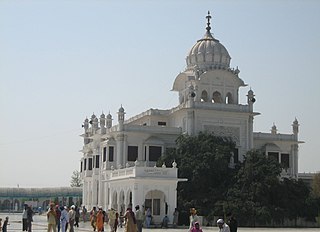
Sultanpur Lodhi is a city and a Municipal Council in the Kapurthala district in the Indian state of Punjab. The town is named after its founder, Bahlol Lodhi, the future Sultan of Delhi who renamed the town in 1443 C.E. during his time as governor of Punjab, and has also been mentioned in the Ain-e-Akbari. Sultanpur Lodhi is located on the south bank of a seasonal rivulet called Kali Bein, which runs 6 miles (9.7 km) north of the confluence of the Beas and Sutlej rivers of Punjab.
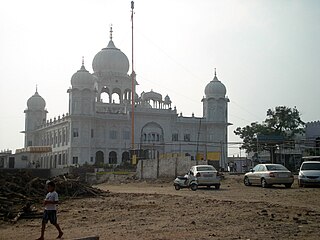
Nada Sahib is a Sikh gurudwara in the Panchkula district of the Indian state of Haryana. Situated on the banks of the Ghaggar-Hakra River in the Sivalik Hills of Panchkula, it is the site where Guru Gobind Singh Ji halted while travelling from Paonta Sahib to Anandpur Sahib after the Battle of Bhangani in 1688.
Palahi is an historical village in Kapurthala, Punjab, India. Palahi is near Phagwara. Neighbouring villages include Khurampur, Khatti, Barn, Kishanpur, Nangal Maja and Dhak Palahi.
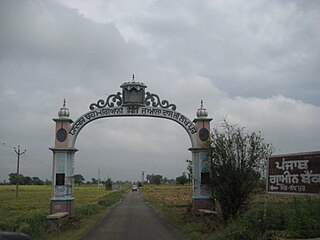
Lakhpur is a village near Sahni (Lakhpur-Sahni), Tehsil Phagwara, Kapurthala district, in Punjab, India.
Chak Prema is a village in Punjab, Tehsil Phagwara, Kapurthala district. The Gate to Lakhpur is located near this village. Neighbouring villages include Lakhpur, Sangatpur, Dhadday, Dhadoli, Bir Dhadoli, Wariah, Gulabgarh and Khatti.
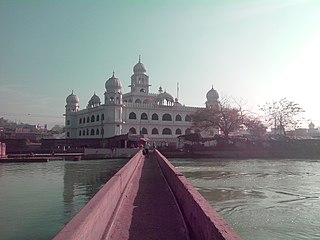
Kiratpur, also known as Kiratpur Sahib, is a town, just 30 km from Rupnagar city in Rupnagar district of Punjab, India. The town is the location of the Gurdwara Patal Puri where many Sikhs take ashes of their deceased.
Babeli is a village in Tehsil Phagwara, Kapurthala district, in Punjab, India.
Rara Sahib is a village near Ludhiana city in Punjab, India. This village was transformed from simple Rara to Rara Sahib due to the visit by the sixth Sikh Guru, Guru Hargobind Ji.
Hadiabad is a historic sub-town in the city of Phagwara in Punjab (India), about 2 kilometres (1.2 mi) west of Phagwara sub-town. It is the biggest area in size on the western part of the city. Many Sikh followers worship at the gurdwara Chhevin Patshahl.
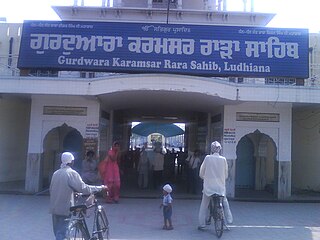
Gurdwara Karamsar Rara Sahib or Gurdwara Rara Sahib is situated at village Rara Sahib near Ludhiana. Rara Sahib is a village near Ludhiana city in Punjab, India. This village was transformed from simple Rara to Rara Sahib due to the visit by the sixth Sikh Guru, Guru Hargobind Ji.
Bija or Beeja is a village and former princely state in the Punjab Hills, in District Ludhiana in India.
Bhai Rupa is a town in the sub-division Rampura Phul in the Bathinda district of the Punjab. It celebrates the name of a prominent Khokhar Sikh, BhaiRupa, the son of Bhai Sadhu, who laid the foundation of the village in 1631, at the instance of Guru Hargobind. Next to BhaiRupa's house, a gurdwara was built in Guru Hargobind's honour. The present Gurdwara Sahib Patshahi Chhevin, a two-storey domed building, marks that site inside the village. Guru ka Langar is across a narrow lane. In the same direction is the pavilion, raised recently to accommodate larger divans.











